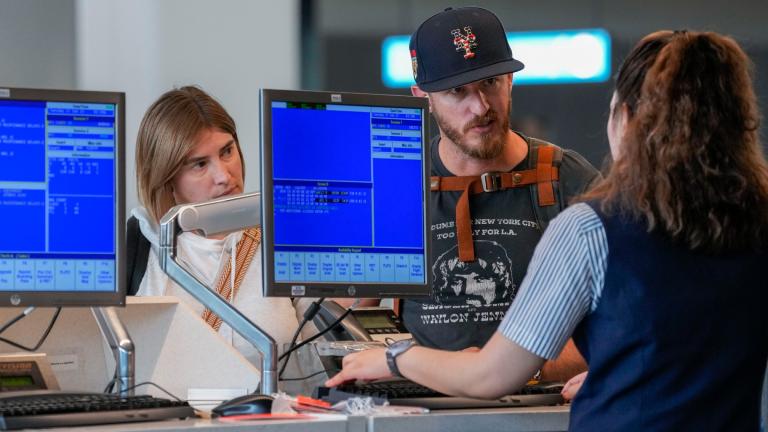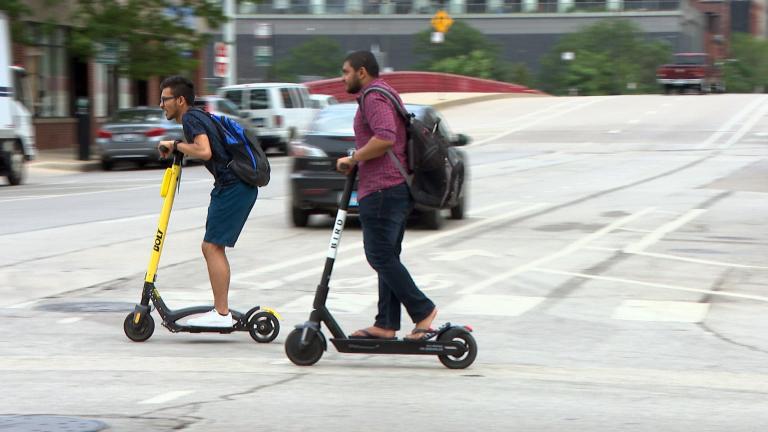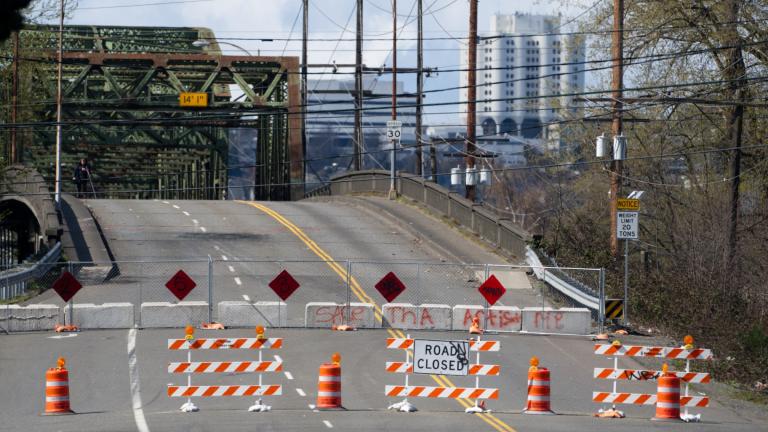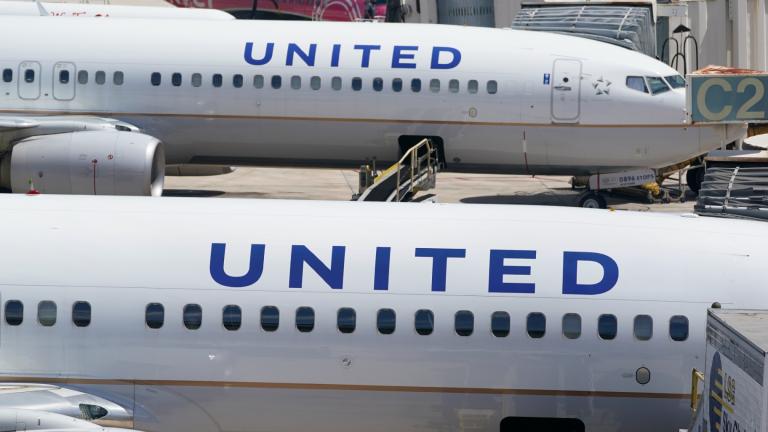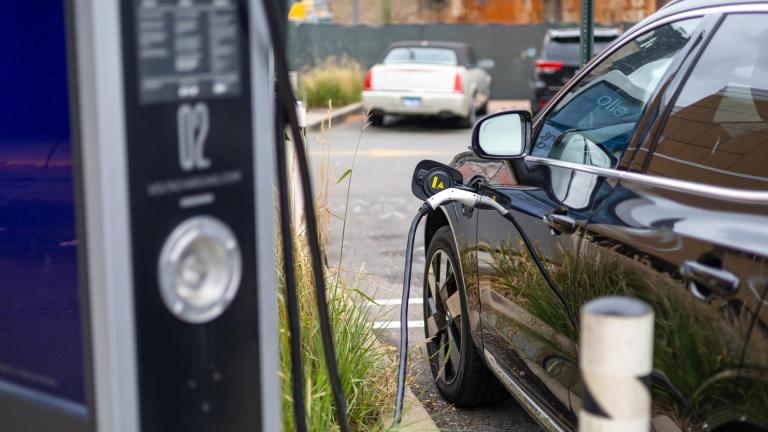The stretch of Sheridan Road that runs through Edgewater is a busy, four-lane thoroughfare lined by lakefront condominiums, with cars zipping by all day long. When a resident of one of those condos was struck by a taxicab outside his building, his neighbors sprang into action.
They sent emails and made phone calls to the local alderperson, advocating for a pedestrian signal with audio cues that would help their neighbor, as well as another blind resident of the building, to get around the community more safely. The alderperson forwarded the request directly to the commissioner of the Mayor’s Office for People with Disabilities, asking for guidance on what she and the Chicago Department of Transportation could do to help those blind residents.
That was in January 2001. Twenty-three years later, there is still no accessible pedestrian signal at the intersection of Sheridan Road and Balmoral Avenue, where the man was hit by a taxi.
The intersection is hardly an anomaly. Fewer than 2% of Chicago’s signalized intersections have an accessible pedestrian signal that provides auditory and tactile guidance to blind, low-vision and deafblind pedestrians — despite more than two decades worth of requests and years of internal acknowledgement from city staffers about the need for such accommodations.
Last year, a federal judge ruled that Chicago’s failure to aid blind pedestrians violated the Americans With Disabilities Act and the Rehabilitation Act, ordering the city to come up with a plan to fix the long-running and potentially deadly problem. But negotiations over that plan between the city and representatives for the plaintiffs, a class of some 66,000 blind and low-vision pedestrians in Chicago, broke down last year. The two sides submitted competing remedial plans to the court in November. Next month, attorneys are set to respond to each other’s filings before handing the matter off to the judge.
The key sticking points are how many of Chicago’s intersections must be outfitted with an accessible pedestrian signal, known as APS, and how long the city will get to come into compliance.
“Blind and low-vision pedestrians need equal access to every single pedestrian signal in the city so that they can cross the street safely, independently and without fear of injury from drivers and vehicles on the street,” said Madeleine Reichman, a senior staff attorney with Disability Rights Advocates, one of the firms representing the plaintiffs in the class action. “Without widespread accessibility, the ideals of the ADA and the Rehabilitation Act aren’t being lived up to right now, and it’s seriously harming a lot of people’s lives.”
The Chicago Department of Transportation said it currently maintains 2,703 signalized intersections with pedestrian signals. In March 2022, CDOT told WTTW News it planned to install 150 APS during 2022 and 2023.
But the agency only installed nine signals in 2022 — one of which was an upgrade to an existing signal — and 12 signals in 2023, bringing the total number of APS across the city to 45. CDOT said it has yet to determine how many APS it plans to install this year.
In a statement to WTTW News, a CDOT spokesperson said the city “fully recognizes the importance of Accessible Pedestrian Signals in ensuring an accessible public way. CDOT incorporates APS signals into all new traffic signal installations, roadway reconstruction projects, and signal modernization projects. The department currently has 135 intersections where APS is in various stages of construction, design, or procurement and will be commencing a citywide retrofit program, which we cannot comment on further due to ongoing litigation.”
“It’s a very, very slow pace of installation that doesn’t come close to what clients and low-vision pedestrians need,” Reichman said. “I think Chicago thinks that they’re doing a reasonably good job, but we know … that it is possible to install these APS on a quicker timeline. Hopefully through the 45 or so APS that the city has installed already, they’re learning how to do it more quickly.”
City Seeks Longer Timeline, Fewer Signals
In 2020, Disability Rights Advocates won a similar case against New York City for its failure to outfit intersections with APS. The following year, a federal judge ordered New York to make 10,000 of its intersections accessible within 10 years, with an additional five years to bring the approximately 4,000 remaining crossings into compliance.
In their remedial plan proposed for Chicago, plaintiffs’ attorneys asked the judge to mandate that Chicago equip all its signalized intersections with APS in 10 years — meaning the city would get the same timeline as New York to perform less than a third of the work.
By contrast, the remedial plan submitted by the city of Chicago asks for a 15-year timeline to outfit with APS just 1,730 of the city’s 2,703 signalized intersections. The filing also said the plan accounts for “an additional 200 intersections that the blind and low vision community will identify, through a community engagement process, that present real concerns to the community.”
That means just over 70% would become accessible to blind pedestrians, which the city argues will fulfill its legal responsibility to provide “meaningful access” under the ADA.
Attorneys cite a variety of complicating factors in the city’s court filing, including budgetary constraints, logistical headaches posed by infrastructure upgrades and difficulty in hiring staff and securing contractors.
“APS installation is a time-consuming, administratively challenging, and expensive process under the best of circumstances,” the city plan reads. “These real constraints faced by the City must be considered in tailoring an appropriate, workable, and achievable remedial plan.”
Attorney Reichman called the scope of the city’s proposal disappointing and a misreading of the law.
“Chicago certainly has had other infrastructure projects on a similar scale that it’s had to fund and execute,” Reichman said. “Given that New York has really been rising to the occasion … we think it’s reasonable to expect that within 10 years, Chicago can do what it needs to do to get all of these intersections equipped with APS.”
The plaintiffs’ remedial plan also calls for mandating a rigorous upkeep program to ensure APS remain in good working order. On two separate visits to Chicago, the mobility consultant hired by the plaintiffs to help develop their plan found that several of the APS already installed by the city weren’t properly installed or maintained.
Longstanding, Well-Known Dangers
Plaintiffs’ attorneys and their consultant both detail the dangers long faced by members of the class. Without accessible signals, blind and low-vision pedestrians are forced to listen for parallel traffic to determine when it’s safe to cross — which can be a risky proposition in a noisy and crowded environment like Chicago.
Court filings extensively outline instances of life-threatening situations faced by blind pedestrians. One of the plaintiffs was struck by a car and hospitalized; another was nearly hit by a bus before being pulled back by an onlooker, with the bus striking her cane and snapping it in two; and a third plaintiff was hit by a car on three different occasions. The years of requests to alderpeople detail similarly harrowing experiences, including a pedestrian trapped in the middle of a roadway with her service dog as traffic raced by and a blind resident of a senior citizen home who was struck by a car.
Seniors with vision problems are of particular importance when installing APS, as the plaintiffs’ mobility consultant noted in her report — especially since older people who may once have been sighted likely don’t have the same kind of orientation and mobility training as pedestrians who have been blind since birth or for many years, and may also be dealing with hearing loss.
Court documents show that alderpeople and city staff were well aware of the accessibility gap long before this lawsuit, with multiple requests for APS as far back as 2001 — though only six of the 38 requests have actually been fulfilled. One request came from the same man who was hit by a cab outside his Edgewater condo building — 17 years after he was struck.
City attorneys claim that “since at least 2015, the City has installed APS in response to community requests.” They also write that Chicago received federal grant money for APS that same year, with the city launching a pilot project in 2016 — a project that wouldn’t be publicly announced until 2019.
A former CDOT official in charge of traffic signal modernization said in a deposition that he advocated for adding APS whenever the city did updates at one of its intersections: “I realized that while APS was not a mandate, it was likely going to be a mandate in the near future, and I thought that it was prudent that our group get out ahead of that and make it standard practice.”
“On one level, I think it is shocking that this has been coming up for literally decades and there’s been barely any movement on it,” Reichman said. “On the other hand, being involved in this kind of work, I’m not surprised at all. This happens across the country with countless different government services.”
Next Steps for Solutions
Now that both sides in the case have filed their respective remedial plans, they’ll get an opportunity to respond to one another in court filings next month.
After that, the federal judge overseeing the class action can either issue a remedial plan herself or hold hearings to help her determine the appropriate scope of a plan.
With an estimated 66,000 blind and low-vision residents in Chicago and 111,000 in Cook County, Reichman said the plaintiffs and their attorneys are hopeful the judge will act quickly after next month’s filings.
“We’re still hopeful that the court will ultimately require Chicago to add APS to all intersections with pedestrian signals, and order it on a timeline of 10 years,” Reichman said.
Contact Nick Blumberg: [email protected] | (773) 509-5434 | @ndblumberg

